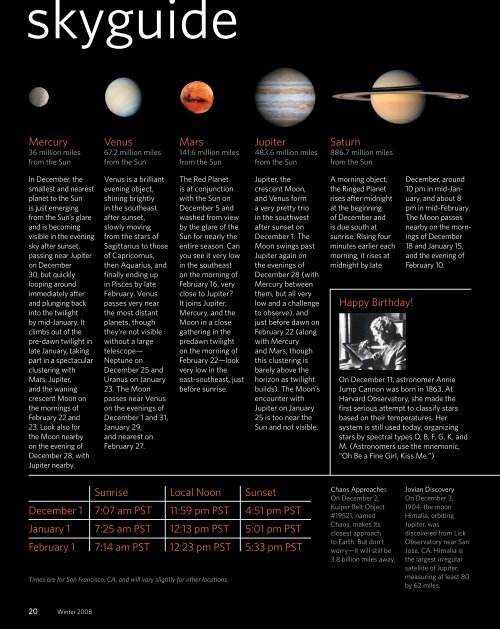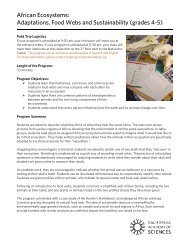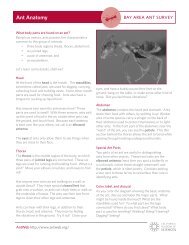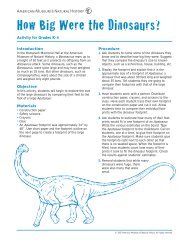Squawk of the town: Academy receives Platinum rating - California ...
Squawk of the town: Academy receives Platinum rating - California ...
Squawk of the town: Academy receives Platinum rating - California ...
You also want an ePaper? Increase the reach of your titles
YUMPU automatically turns print PDFs into web optimized ePapers that Google loves.
skyguide<br />
Mercury<br />
36 million miles<br />
from <strong>the</strong> Sun<br />
Venus<br />
67.2 million miles<br />
from <strong>the</strong> Sun<br />
Mars<br />
141.6 million miles<br />
from <strong>the</strong> Sun<br />
Jupiter<br />
483.6 million miles<br />
from <strong>the</strong> Sun<br />
Saturn<br />
886.7 million miles<br />
from <strong>the</strong> Sun<br />
In December, <strong>the</strong><br />
smallest and nearest<br />
planet to <strong>the</strong> Sun<br />
is just emerging<br />
from <strong>the</strong> Sun’s glare<br />
and is becoming<br />
visible in <strong>the</strong> evening<br />
sky after sunset,<br />
passing near Jupiter<br />
on December<br />
30, but quickly<br />
looping around<br />
immediately after<br />
and plunging back<br />
into <strong>the</strong> twilight<br />
by mid-January. It<br />
climbs out <strong>of</strong> <strong>the</strong><br />
pre-dawn twilight in<br />
late January, taking<br />
part in a spectacular<br />
clustering with<br />
Mars, Jupiter,<br />
and <strong>the</strong> waning<br />
crescent Moon on<br />
<strong>the</strong> mornings <strong>of</strong><br />
February 22 and<br />
23. Look also for<br />
<strong>the</strong> Moon nearby<br />
on <strong>the</strong> evening <strong>of</strong><br />
December 28, with<br />
Jupiter nearby.<br />
Venus is a brilliant<br />
evening object,<br />
shining brightly<br />
in <strong>the</strong> sou<strong>the</strong>ast<br />
after sunset,<br />
slowly moving<br />
from <strong>the</strong> stars <strong>of</strong><br />
Sagittarius to those<br />
<strong>of</strong> Capricornus,<br />
<strong>the</strong>n Aquarius, and<br />
finally ending up<br />
in Pisces by late<br />
February. Venus<br />
passes very near<br />
<strong>the</strong> most distant<br />
planets, though<br />
<strong>the</strong>y’re not visible<br />
without a large<br />
telescope—<br />
Neptune on<br />
December 25 and<br />
Uranus on January<br />
23. The Moon<br />
passes near Venus<br />
on <strong>the</strong> evenings <strong>of</strong><br />
December 1 and 31,<br />
January 29,<br />
and nearest on<br />
February 27.<br />
The Red Planet<br />
is at conjunction<br />
with <strong>the</strong> Sun on<br />
December 5 and<br />
washed from view<br />
by <strong>the</strong> glare <strong>of</strong> <strong>the</strong><br />
Sun for nearly <strong>the</strong><br />
entire season. Can<br />
you see it very low<br />
in <strong>the</strong> sou<strong>the</strong>ast<br />
on <strong>the</strong> morning <strong>of</strong><br />
February 16, very<br />
close to Jupiter?<br />
It joins Jupiter,<br />
Mercury, and <strong>the</strong><br />
Moon in a close<br />
ga<strong>the</strong>ring in <strong>the</strong><br />
predawn twilight<br />
on <strong>the</strong> morning <strong>of</strong><br />
February 22—look<br />
very low in <strong>the</strong><br />
east-sou<strong>the</strong>ast, just<br />
before sunrise.<br />
Jupiter, <strong>the</strong><br />
crescent Moon,<br />
and Venus form<br />
a very pretty trio<br />
in <strong>the</strong> southwest<br />
after sunset on<br />
December 1. The<br />
Moon swings past<br />
Jupiter again on<br />
<strong>the</strong> evenings <strong>of</strong><br />
December 28 (with<br />
Mercury between<br />
<strong>the</strong>m, but all very<br />
low and a challenge<br />
to observe), and<br />
just before dawn on<br />
February 22 (along<br />
with Mercury<br />
and Mars, though<br />
this clustering is<br />
barely above <strong>the</strong><br />
horizon as twilight<br />
builds). The Moon’s<br />
encounter with<br />
Jupiter on January<br />
25 is too near <strong>the</strong><br />
Sun and not visible.<br />
A morning object,<br />
<strong>the</strong> Ringed Planet<br />
rises after midnight<br />
at <strong>the</strong> beginning<br />
<strong>of</strong> December and<br />
is due south at<br />
sunrise. Rising four<br />
minutes earlier each<br />
morning, it rises at<br />
midnight by late<br />
Happy Birthday!<br />
December, around<br />
10 pm in mid-January,<br />
and about 8<br />
pm in mid-February.<br />
The Moon passes<br />
nearby on <strong>the</strong> mornings<br />
<strong>of</strong> December<br />
18 and January 15,<br />
and <strong>the</strong> evening <strong>of</strong><br />
February 10.<br />
On December 11, astronomer Annie<br />
Jump Cannon was born in 1863. At<br />
Harvard Observatory, she made <strong>the</strong><br />
first serious attempt to classify stars<br />
based on <strong>the</strong>ir temperatures. Her<br />
system is still used today, organizing<br />
stars by spectral types O, B, F, G, K, and<br />
M. (Astronomers use <strong>the</strong> mnemonic,<br />
“Oh Be a Fine Girl, Kiss Me.”)<br />
Sunrise Local Noon Sunset<br />
December 1 7:07 am PST 11:59 pm PST 4:51 pm PST<br />
January 1 7:25 am PST 12:13 pm PST 5:01 pm PST<br />
February 1 7:14 am PST 12:23 pm PST 5:33 pm PST<br />
Times are for San Francisco, CA, and will vary slightly for o<strong>the</strong>r locations.<br />
Chaos Approaches<br />
On December 2,<br />
Kuiper Belt Object<br />
#19521, named<br />
Chaos, makes its<br />
closest approach<br />
to Earth. But don’t<br />
worry—it will still be<br />
3.8 billion miles away.<br />
Jovian Discovery<br />
On December 3,<br />
1904, <strong>the</strong> moon<br />
Himalia, orbiting<br />
Jupiter, was<br />
discovered from Lick<br />
Observatory near San<br />
Jose, CA. Himalia is<br />
<strong>the</strong> largest irregular<br />
satellite <strong>of</strong> Jupiter,<br />
measuring at least 80<br />
by 62 miles.<br />
20 Winter 2008



![download [PDF - 2.7mb] - California Academy of Sciences](https://img.yumpu.com/26596748/1/190x122/download-pdf-27mb-california-academy-of-sciences.jpg?quality=85)








![Download a visitor map [418k] - California Academy of Sciences](https://img.yumpu.com/26596645/1/190x88/download-a-visitor-map-418k-california-academy-of-sciences.jpg?quality=85)



